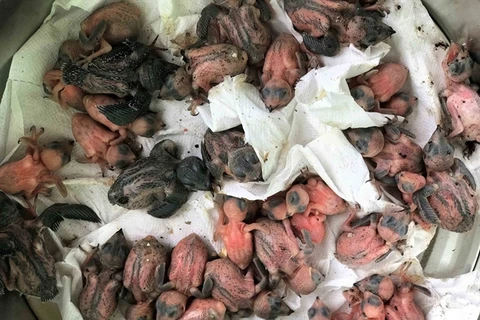
Hanoi (VNA) - After 15 years of conservation and development, the Cu Lao Cham ecosystem in Hoi An city, in the central province of Quang Nam has been restored to an attractive destination on the country's tourist map.
On May 26, 2009, with its rich flora and fauna and historical relic sites dating back hundreds of years, Cu Lao Cham was recognised by the United Nations Educational, Scientific and Cultural Organisation (UNESCO) as a World Biosphere Reserve.
In October 2003, the Cu Lao Cham Nature Reserve was established to preserve wildlife on the island. It is one of the 15 marine protected areas of Vietnam (data in 2007). Located downstream of the Thu Bon River, the Cu Lao Cham-Hoi An World Biosphere Reserve boasts a unique and diverse ecosystem, including an estuary and coastal areas, allowing a close connection with nature.
The reserve has a total area of 33,475 hectares, divided into three functional zones.
The core zone – Cu Lao Cham Marine Protected Area, covering 11,560 hectares, is a marine protected area and is home to the Cu Lao Cham special-use forest conservation force.

The area has more than 311 hectares of coral reefs, with 50 hectares of seagrass beds. There are 76 species of seaweed, more than 270 species of fish, 97 species of mollusks, and 11 species of echinoderms.
The Cu Lao Cham special use forest has 499 species of 352 genera and 115 families among high-level plants in Vietnam.
The Cu Lao Cham Marine Protected Area makes an important contribution to preserving biodiversity, supporting development, improving livelihoods for resident communities, and raising community awareness of environmental protection.
This island is the first place in the country to “say no to nylon bags" and "say no to plastic straws". It also aims to “say no to single-use plastic waste”.
The buffer zone - Thu Bon estuary region is the area from the sea to the mainland stretching up to 20.35 hectares.
The Thu Bon estuary region inherits a diverse ecosystem with a system of rivers, canals, beaches, and mangrove forests, mainly nipa palms.
Cam Thanh nipa palm forest, a once famous revolutionary base, has now become an attractive destination for tourists who want to experience the scenery of southern river villages right in the central region.
This place is also the spawning ground for many aquatic species and plays a very important role in controlling water quality before flowing out to the sea and ensuring the ecological connection between continents and oceans.
The transitional zone is the remaining natural area, notably Hoi An ancient town, which attracts tourists with a beauty featuring both traditional space and the breath of the new era.
Hoi An has a total of 1,406 relic sites in the protection list, including 28 national and 44 provincial sites.

In addition to tangible cultural heritage, Hoi An ancient town is also considered a "living heritage," containing many intangible cultural values related to the daily life of local residents, with dishes, festivals, lifestyle and daily activities.
In addition, many traditional craft villages and festivals are still maintained in community life around the ancient town.
Over the past 15 years, the Cu Lao Cham-Hoi An World Biosphere Reserve has strictly complied with regulations and meet UNESCO's requirements set for a biosphere.
Many tourism businesses in Hoi An and Cu Lao Cham are gradually converting disposable plastic products to reusable items.
Community awareness of conservation and sustainable development of species has been increasingly enhanced. Activities on Cu Lao Cham are aiming for Vietnam's first plastic waste-free island model. In particular, in addition to limiting the use of disposable plastic products, this place has successfully built and operated a resource recovery facility in Bai Ong village.
With a new monitoring method, databases collected from undersea cross sections and 6 coral reef areas, all types of plastic waste will be collected.
According to UNESCO, the Cu Lao Cham-Hoi An World Biosphere Reserve is a clear example of the connection and harmony between nature and humans. The title of “World Biosphere Reserve” is the global community's recognition of Hoi An city's outstanding efforts in preserving and promoting the values of natural resources toward sustainable development, it said./.






















